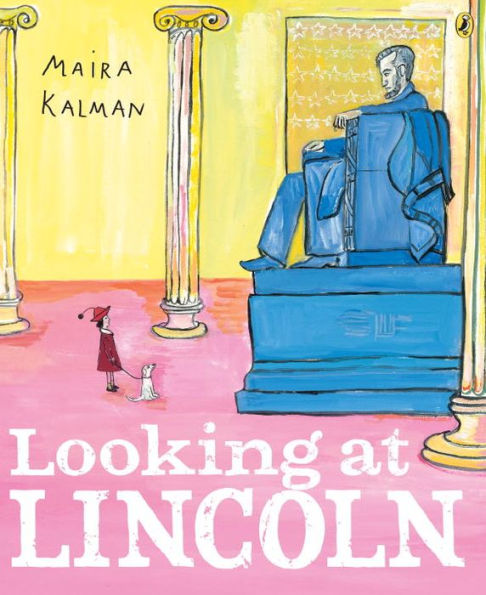"Kalman's text is marvelously tuned to young readers. . . . an utterly winning tribute."—The New York Times
* "Kalman's fond and bittersweet account of our lanky 16th president evokes both a schoolgirl crush and a Yankee's steely, sorrowful perspective on the price of freedom. . . . Rather than pen a textbook profile, Kalman portrays heartfelt admiration through poignant imagery."—Publishers Weekly, starred review
* “With a breezy conversational style, thick lines, and vivid bulky colors, Kalman provides a unique introduction to our 16th president. . . . Fascinating lesser-known facts. . . . With each spread, readers will discover unusual and varying visuals. . . . An effective and memorable ending. . . . A great read-aloud for younger children with lots of possibilities for discussion and a jumping-off point for older readers to motivate their research. . . . Captivating.”—School Library Journal, starred review
"Profusion of bright gouache illustrations that are as colorful as springtime in Arles. . . . Encourages historical examination."—The Horn Book
"Appealingly childlike. . . . Kalman's artwork is the main attraction here, with appealing naive illustrations done in gouache. Each page offers visual treats in a Matisse-like palette."—Kirkus Reviews
"Remarkable. . . . Questions that echo a child's curiosity. . . . This impressionistic biography is one that adults will want to share with children, and that children will pore over."—Library Media Connection
"Embellished with circular, childlike wonderings. . . . Powerful emotional impact."—Booklist
"Embellished with circular, childlike wonderings. . . . Powerful emotional impact."
"Remarkable. . . . Questions that echo a child's curiosity. . . . This impressionistic biography is one that adults will want to share with children, and that children will pore over."
"Profusion of bright gouache illustrations that are as colorful as springtime in Arles. . . . Encourages historical examination."
Gr 2–5—With a breezy conversational style, thick lines, and vivid bulky colors, Kalman provides a unique introduction to our 16th president. She begins by drawing attention to Lincoln's tall stovepipe hat, the appearance of his face on the $5 bill, and the many (more than 16,000) books written about him. As the narrative continues, the author integrates information about Lincoln's impoverished childhood, study of law, election as president, Gettysburg address, Emancipation Proclamation, and murder in 1865, while also addressing fascinating lesser-known facts—his run-in with a donkey, favorite kind of cake, and the name of his dog. With each spread, readers will discover unusual and varying visuals: splashy pinks during cherry-blossom season in Washington DC, solemn portraits of Sojourner Truth and Frederick Douglass, a bullet-ridden uniform of a Civil War soldier, the boy Abe reading by the fire, and a riderless horse with boots on backward signaling Lincoln's death. In an effective and memorable ending, Kalman closes with a Lincoln quote: "…With malice toward none, with charity for all," setting the words against a view of the Lincoln Memorial. A list of sources and appended notes add breadth to the presentation. This is a great read-aloud for younger children with lots of possibilities for discussion and a jumping-off point for older readers to motivate their research. Regardless of the number of Lincoln books already on the shelves, librarians will want to add this captivating book to their collections.—Barbara Elleman, Eric Carle Museum of Picture Book Art, Amherst, MA
Kalman's narrator sees a man who reminds her of Abraham Lincoln and goes to the library to find out more about the 16th president in this appealingly childlike introduction. She finds information about Lincoln's family life, his education, how he dressed, his presidency and his death. She wonders what he thought about, and she offers information about his anti-slavery views and his meetings with Sojourner Truth and Frederick Douglass. Kalman's artwork is the main attraction here, with appealing naive illustrations done in gouache. Each page offers visual treats in a Matisse-like palette, unusual for a biography of a president, but fun in their own right--images of various people and items related to the president, including pancakes, a vanilla cake, a whistle, apples and, toward the end, an ominous-looking gun facing a rocking chair with a top hat on the floor. In the compression necessary to the picture-book form, however, history is regrettably oversimplified. Lincoln did indeed hate slavery and did say, as the narrator states, "If slavery is not wrong, nothing is wrong," But to assert that "[t]he Northern states (the Union) believed that slavery should be abolished. And so they went to war," is to offer children a not-quite-accurate version of history adults should be ready to contextualize. In enjoying the art, readers will pick up some bits of history along the way. (notes, sources) (Picture book/biography. 5-8)




